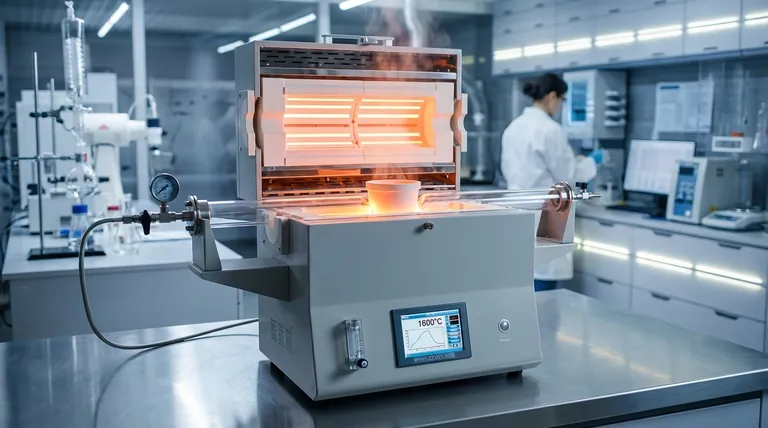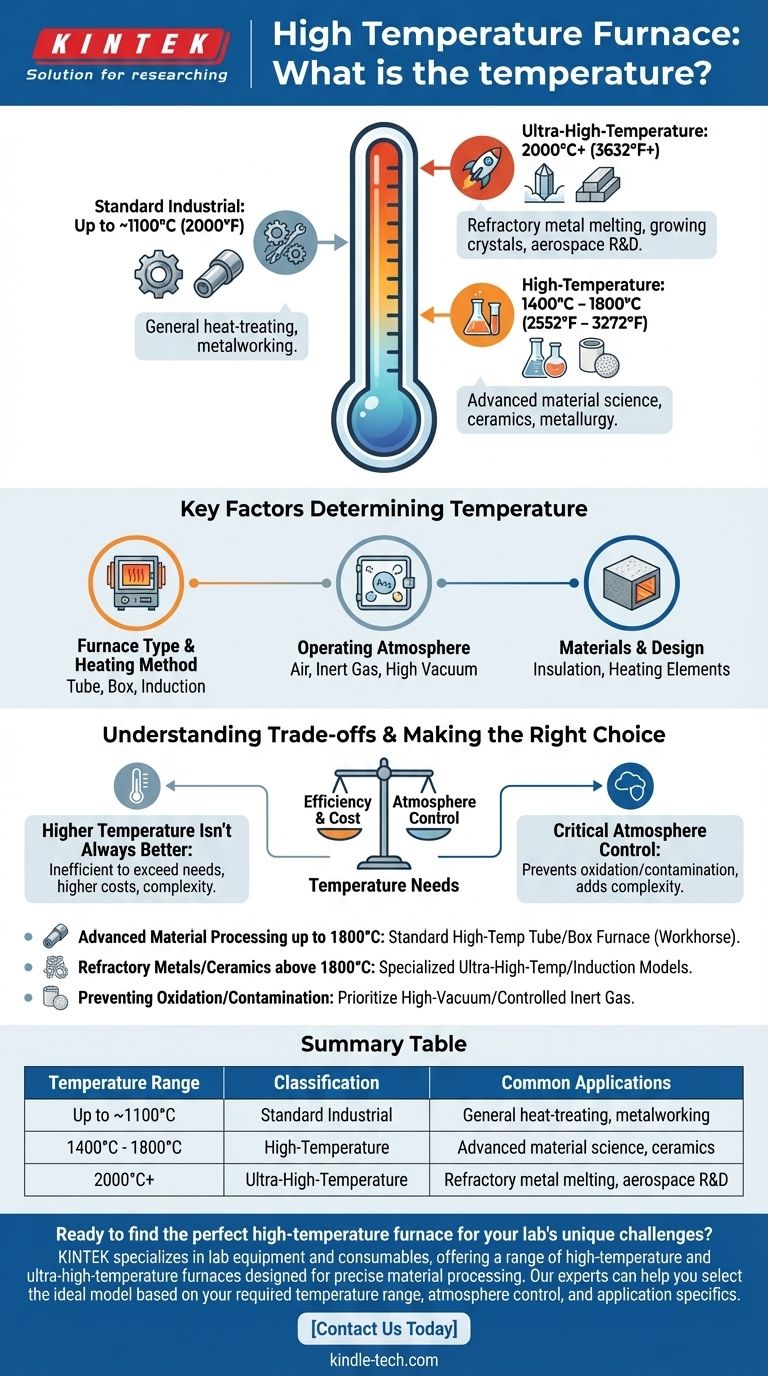For industrial and research applications, a high-temperature furnace typically operates in the range of 1400°C to 1800°C (2552°F to 3272°F). However, specialized models known as ultra-high-temperature furnaces are engineered to exceed this, reaching up to 2000°C or even higher under precisely controlled atmospheric conditions.
The term "high temperature" is not a single value but a classification for furnaces designed for processes beyond the limits of standard equipment. The exact temperature capability is determined by the furnace's specific type, heating method, and its intended application.

Defining the "High Temperature" Threshold
Understanding what qualifies as a "high temperature" furnace requires establishing a baseline. Not all industrial furnaces are designed for the extreme conditions required in specialized material science, metallurgy, or advanced ceramics research.
The Standard Industrial Baseline
Many common industrial furnaces, such as those powered by natural gas, operate at temperatures up to approximately 1100°C (around 2000°F). This range is sufficient for many heat-treating and metalworking applications.
The High-Temperature Leap
High-temperature furnaces are specifically designed to operate reliably above this baseline. The range of 1400°C to 1800°C represents a significant engineering challenge, requiring different materials for heating elements and insulation to function without failure.
The Ultra-High-Temperature Category
For the most demanding applications, ultra-high-temperature furnaces push the limits further, reaching 2000°C and beyond. These are highly specialized instruments used for melting refractory metals, growing crystals, or testing materials for aerospace applications.
Key Factors That Determine Furnace Temperature
A furnace's maximum temperature is not an arbitrary number. It is the result of its core design, the materials used in its construction, and the environment it creates internally.
Furnace Type and Heating Method
Different designs achieve high temperatures in unique ways. Tube and box furnaces often use resistive heating elements, while induction furnaces use electromagnetic induction to heat the material directly, allowing them to reach 1800°C or more with great efficiency.
Operating Atmosphere
Temperature is only one part of the equation. Many high-temperature processes must occur in a controlled environment to prevent oxidation or contamination. Furnaces may operate in the open air, with an inert gas like argon, or under a high vacuum to protect the material being processed.
Understanding the Trade-offs
Selecting a furnace involves more than just finding the one with the highest temperature rating. The right choice depends on a careful balance of process requirements, material compatibility, and operational complexity.
Higher Temperature Isn't Always Better
Choosing a furnace that dramatically exceeds your needs is inefficient. The energy costs, material wear, and complexity of operating at 1800°C are substantially higher than at 1400°C. The goal is to match the equipment to the specific application.
The Critical Role of Atmosphere Control
A furnace that can reach 2000°C in the air is fundamentally different from one that achieves the same temperature under a high vacuum. Processes involving reactive metals or sensitive materials depend on the furnace's ability to provide a non-reactive environment, which adds significant complexity and cost.
Making the Right Choice for Your Application
To select the appropriate equipment, you must first define your primary objective.
- If your primary focus is advanced material processing up to 1800°C: A standard high-temperature tube or box furnace is the industry workhorse for these applications.
- If your primary focus is research on refractory metals or advanced ceramics above 1800°C: You will need to investigate specialized ultra-high-temperature or induction furnace models.
- If your primary focus is preventing material oxidation or contamination: Prioritize furnaces with high-vacuum or controlled inert gas capabilities suitable for your target temperature range.
Ultimately, understanding the relationship between temperature, furnace type, and atmosphere is the key to achieving precise and repeatable results.
Summary Table:
| Temperature Range | Classification | Common Applications |
|---|---|---|
| Up to ~1100°C | Standard Industrial | General heat-treating, metalworking |
| 1400°C - 1800°C | High-Temperature | Advanced material science, ceramics |
| 2000°C+ | Ultra-High-Temperature | Refractory metal melting, aerospace R&D |
Ready to find the perfect high-temperature furnace for your lab's unique challenges? KINTEK specializes in lab equipment and consumables, offering a range of high-temperature and ultra-high-temperature furnaces designed for precise material processing. Our experts can help you select the ideal model based on your required temperature range, atmosphere control, and application specifics. Contact us today to discuss your needs and enhance your lab's capabilities!
Visual Guide

Related Products
- 1400℃ Laboratory Quartz Tube Furnace with Alumina Tube Tubular Furnace
- Laboratory Muffle Oven Furnace Bottom Lifting Muffle Furnace
- 1700℃ Laboratory Quartz Tube Furnace with Alumina Tube Tubular Furnace
- 1700℃ Controlled Atmosphere Furnace Nitrogen Inert Atmosphere Furnace
- Vertical Laboratory Quartz Tube Furnace Tubular Furnace
People Also Ask
- What is the high temperature of a tube furnace? Unlock the Right Model for Your Application
- What is a tube furnace used for? Achieve Precise, Controlled Thermal Processing
- What precautions should be taken when using a tube furnace? Ensure Safe, Effective High-Temperature Processing
- What are the benefits of a tube furnace? Achieve Superior Temperature & Atmosphere Control
- What is a tubular furnace used for? Precision Heating for Material Synthesis & Analysis



















